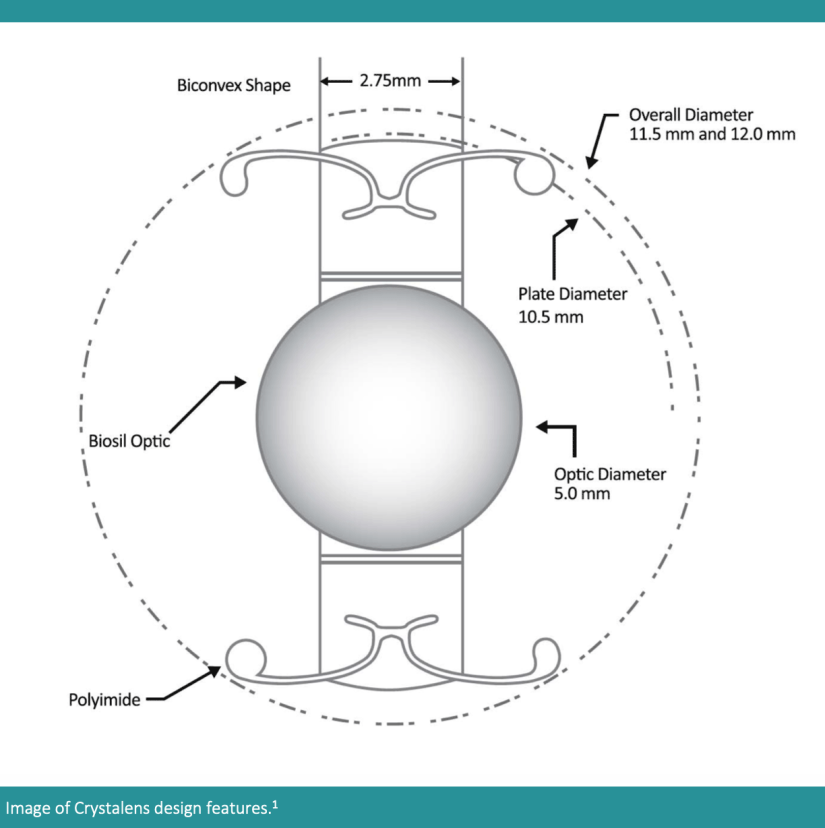Crystalens® Delivers Clear Vision with Minimal Halos and Glare1-3
Crystalens® AO is the only FDA-approved accommodating intraocular lens (IOL) on the market with a lower risk of positive dysphotopsias compaired to multifocal. Even as cataract surgeons have embraced advanced multifocal diffractive technology, many still consider Crystalens an important option that enables delivery of the quality of vision patients expect.
Crystalens generates fewer halos compared to other multifocal lenses.1,2 This is a benefit for all patients, especially because glare and halos are real issues for people who are driving at night. Crystalens has minimal glare and halos because it has one distinct point of focus and changes position and functional power within the capsular bag to deliver clear vision.4
Crystalens AO Offers Patients an Excellent Range of Vision
For many patients, Crystalens is a great option. According to doctors, there are many patients who may be candidates for this versatile lens technology. For example, patients with complicated corneas (i.e. post-radial keratotomy) are good candidates for Crystalens due to the spherical aberration neutral design.
Crystalens Has a Unique, Aspheric Neutral Design
Crystalens is an aberration-free lens, with uniform power across the lens.1 In comparison, most modern presbyopia-correcting IOLs are designed with negative asphericity built into an aspheric platform. The neutral asphericity makes Crystalens more forgiving of higher-order aberrations (HOAs), coma, and decentration.
Unlike single-piece IOLs designed with two haptics and three points of contact, Crystalens has five points of contact, making it less likely to rotate as a result of capsular contraction. As long as the patient is looking through the lens, they will see well.

Surgical Pearls for Crystalens
There are surgical techniques that physicians use when implanting Crystalens. First, polish the capsule for even healing in the postoperative period. If healing is uneven for some reason, a YAG capsulotomy can be used to address the unequal forces. Second, make sure the wounds are watertight with no micro leaks at the end of the case.
Dr. Inder Paul Singh, an ophthalmologist from Wisconsin noted, “When I consider the risk-benefit ratio, I find that I have fewer risks with Crystalens compared with all of the potential issues with diffractive lens outcomes. The surgery itself is straightforward with minimal intraoperative manipulation.”
Dr. Ralph Chu of Bloomington, Minnesota and Dr. Singh discussed some considerations for surgeons acclimating to Crystalens IOL. Their recommendations are:
- Start with eyes in the traditional range
- Avoid the extremes of axial length (ie, high hyperopes and high myopes). Avoid short or very long eyes until you’ve had some experience with the lens
- High myopia with flatter Ks and a normal axial length are great candidates for Crystalens. Mid-range myopes are also great candidates
- Avoid patients with mild cataracts or low myopia. Choose someone who has a significant cataract or who is a successful monovision contact lens wearer
- A low hyperope who has a fairly significant cataract, whether or not they have tried monovision, is a good patient for Crystalens
- Polish the capsule. This step eliminates capsular phimosis syndrome. If an IOL exchange is ever necessary, the capsule will be clean if it was polished. Also, with pseudoexfoliation patients, there’s less chance for capsular contraction and lens decentration
- Post refractive surgery patients—post-myopic or hyperopic LASIK and post-RK—who are significantly motivated to have better-than-basic correction are good Crystalens candidates. These patients often have slightly decentered ablations and induced spherical aberrations from their ablation patterns
“Crystalens generates minimal halos, which is a benefit for patients who want to drive after dark.”
- Dr. Mitchell Shultz of Shultz Chang Vision in Northridge, California
“Crystalens is my do-no-harm lens for patients who have complex corneas, dry eye, imperfect macula, mild glaucoma, or personalities that aren't ideal for diffractive optics or other types of refractive optics. That’s why I chose it for my father, who's a surgeon himself and a type A++ personality. It was my clear, easy choice because I wanted to ensure that he got excellent distance vision without dysphotopsias.”
- Dr. Neel Desai of The Eye Institute of West Florida
Y. Ralph Chu, MD, Chu Vision Institute, Bloomington, Minnesota
I. Paul Singh, MD, The Eye Centers of Racine & Kenosha, Wisconsin
Neel R. Desai, MD, The Eye Institute of West Florida, St. Petersburg, Florida
Mitchell C. Shultz, MD, Shultz Chang Vision, Northridge, California